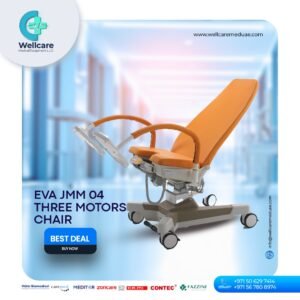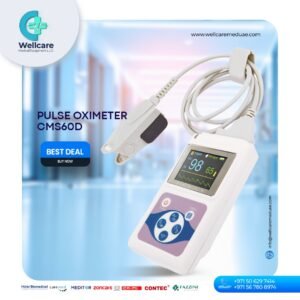Medical Furniture supplier in UAE
WellCare Medical Equipment LLC is a prominent supplier of medical furniture and equipment in the UAE, known for its comprehensive range of products tailored to meet the needs of healthcare facilities. The company specializes in providing high-quality medical furniture that enhances both patient care and operational efficiency in hospitals, clinics, and other medical settings. Their offerings include examination tables, hospital beds, patient recliners, and a variety of other essential items designed to support healthcare professionals and ensure patient comfort. WellCare Medical Equipment LLC distinguishes itself through its commitment to quality and reliability, sourcing products that adhere to international standards and regulations. They focus on providing durable, functional, and ergonomically designed furniture that aligns with the latest advancements in medical technology and design. Their extensive catalog caters to diverse needs, from basic healthcare requirements to more specialized equipment, ensuring that healthcare providers can find the right solutions for their specific requirements. In addition to their product range, WellCare Medical Equipment LLC is recognized for its exceptional customer service, offering support and guidance throughout the purchasing process. This includes detailed product information, installation services, and after-sales support to ensure that clients receive the best possible value from their investment. The company’s dedication to meeting the evolving demands of the healthcare sector makes it a trusted partner for medical institutions across the UAE.
Medical furniture is specialized equipment designed to support healthcare settings such as hospitals, clinics, and laboratories. It plays a crucial role in patient care, medical procedures, and the overall functionality of medical facilities. Here’s an overview of different types of medical furniture and their importance:
1. Examination Tables
Examination tables are fundamental in any medical facility. They provide a comfortable and adjustable surface for patients during medical examinations and procedures. Features often include adjustable height, backrests, and leg rests to accommodate various patient needs and positions. Some examination tables come with built-in storage for medical supplies and instruments.
2. Hospital Beds
Hospital beds are designed for patient comfort and ease of care. They typically have adjustable sections for the head, legs, and overall height, allowing for various positions to enhance patient comfort and facilitate medical treatments. Advanced models may include features like powered adjustments, side rails for safety, and built-in monitoring systems.
3. Patient Recliners
Patient recliners offer comfort for patients during longer periods of sitting or recovery. They are often used in outpatient settings, dialysis centers, and rehabilitation facilities. Features may include adjustable reclining positions, removable trays, and storage compartments. They are designed to provide comfort and support for extended periods.
4. Wheelchairs
Wheelchairs are essential for mobility-impaired patients, providing support and ease of movement within healthcare facilities. They come in various types, including manual, powered, and specialized models for different medical conditions. Features can include adjustable footrests, armrests, and seating options for comfort and functionality.
5. IV Stands and Drip Stands
IV stands and drip stands are used to hold intravenous (IV) bags and other medical fluids. They are designed to be adjustable in height and have a stable base to prevent tipping. These stands are critical for administering medications and fluids to patients in a variety of healthcare settings.
6. Medical Cabinets and Storage
Medical cabinets and storage solutions are used to organize and store medical supplies, medications, and equipment. They come in various sizes and configurations, including lockable cabinets for controlled substances. Proper storage solutions help maintain an organized and efficient medical environment.
7. Overbed Tables
Overbed tables provide a convenient surface for patients to use while in bed. They are adjustable in height and can be positioned over the bed to allow patients to eat, read, or use electronic devices comfortably. These tables are commonly used in hospitals and long-term care facilities.
8. Procedure Chairs
Procedure chairs are designed for various medical procedures, such as minor surgeries, blood draws, or diagnostic tests. They typically offer adjustable positions, including reclining and swiveling capabilities, to provide optimal access and comfort during procedures.
9. Waiting Room Furniture
Waiting room furniture includes chairs, sofas, and tables designed for patient comfort and convenience in waiting areas. This furniture is often durable and easy to clean, as well as designed to accommodate a range of patients and visitors.
10. Bedside Cabinets
Bedside cabinets provide convenient storage for personal items and medical supplies close to a patient’s bed. They often include drawers and compartments for organization and may feature a top surface for placing personal items or medical equipment.
11. Medical Desks and Workstations
Medical desks and workstations are used by healthcare professionals for administrative tasks, patient record management, and data entry. They are designed to be ergonomic and functional, often including features like adjustable heights, ample workspace, and integrated technology.
Importance of Medical Furniture:
- Patient Comfort and Care: Well-designed medical furniture enhances patient comfort, which is crucial for recovery and overall well-being. It also facilitates effective care and treatment by providing appropriate support during medical procedures.
- Functionality and Efficiency: Medical furniture helps healthcare professionals perform their duties efficiently and effectively. Adjustable and versatile designs contribute to better workflow and ease of use in various medical procedures.
- Safety and Hygiene: Medical furniture is designed with safety and hygiene in mind. Features such as easy-to-clean surfaces, safety rails, and stability contribute to a safer and more hygienic environment for both patients and healthcare providers.
- Compliance and Regulation: Medical furniture must adhere to industry standards and regulations to ensure safety and functionality. Compliance with these standards is essential for maintaining high-quality care and meeting healthcare facility requirements.
Medical furniture plays a critical role in supporting the diverse needs of patients and healthcare professionals. Its design and functionality are essential for creating an efficient, comfortable, and safe healthcare environment.
Does Well Care offer warranty and maintenance support?
Yes. All medical furniture products come with a warranty and optional maintenance packages to ensure long-lasting performance.




